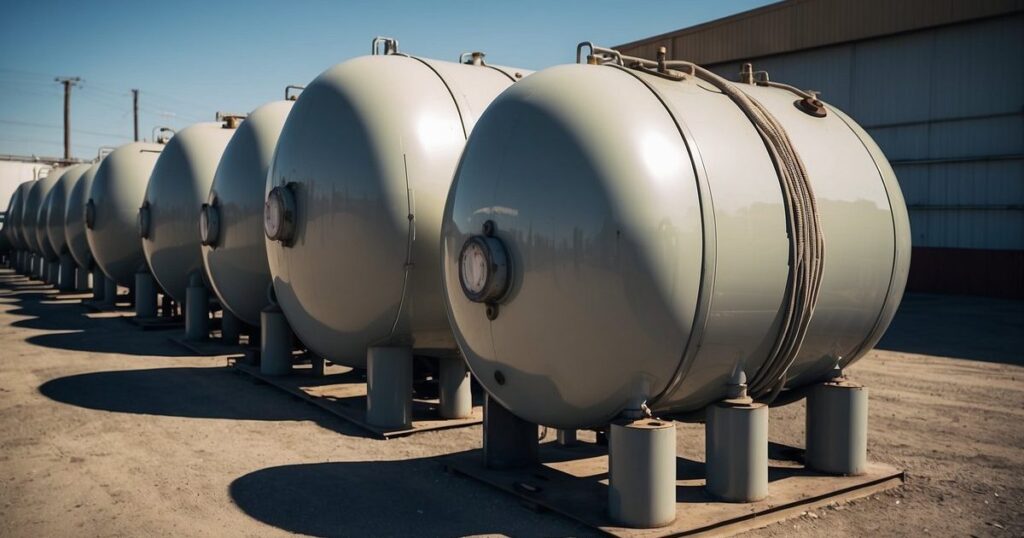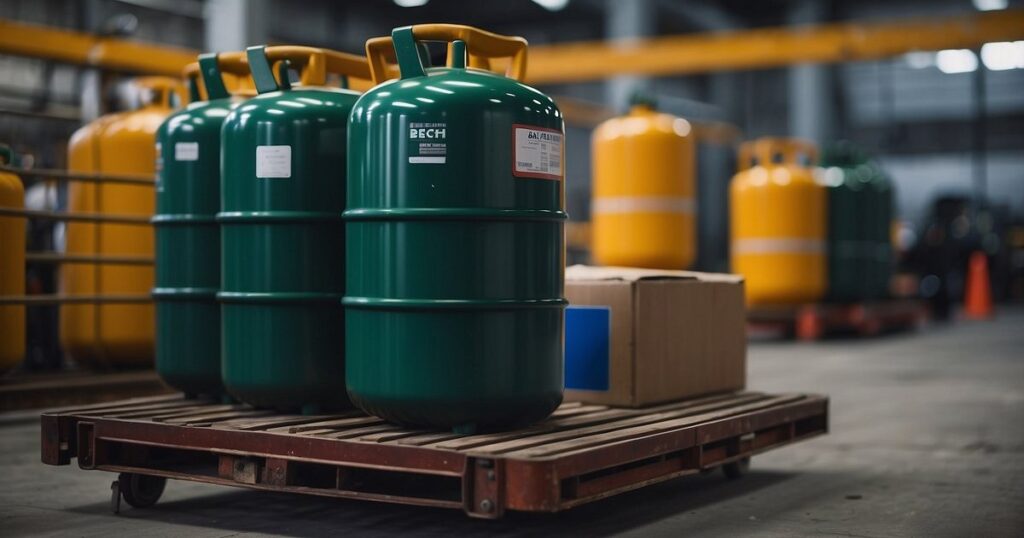Storing and transporting industrial gases safely and efficiently is a complex process that requires rigorous standards and advanced technology. Your understanding of industrial gas storage and transportation processes is essential, as these gases play a critical role across a multitude of industries, from manufacturing to healthcare. Furthermore, the gases, which typically include oxygen, nitrogen, carbon dioxide, argon, hydrogen, helium, and acetylene, often come under high pressure or in low-temperature conditions, adding layers of complexity to their containment and movement.
Your awareness of the storage mechanisms, such as cylinders, dewars, and tanks, is paramount since they must withstand the gases’ properties and maintain their integrity over time. Transportation, whether by road or pipelines, demands strict adherence to safety regulations to prevent leaks and ensure the gases’ purity. Because these substances can be flammable, toxic, or reactive, you must ensure the equipment used meets appropriate standards and that safety measures are in place to mitigate risks.
Encountering the challenges of temperature control, pressure management, and compliance with regulations is inevitable. Solutions to these challenges involve using materials and technologies designed to handle extreme conditions, as well as implementing monitoring systems to detect and address any potential breaches quickly. Your objective is to maintain a seamless flow of these vital resources, safeguarding not only the industries that rely on them but also the environment and public health.
Industrial Gas Storage Solutions

In handling industrial gases like hydrogen, nitrogen, oxygen, and argon, your approach to storage is crucial for maintaining safety, adhering to regulations, and ensuring cost-effectiveness.
Types and Characteristics of Storage Systems
Industrial gases are stored in various forms, primarily under high pressure or low temperature, to maintain their gaseous or liquid states. The most common storage systems include:
- Gas Cylinders: Ideal for gases at ambient temperature with varying pressure requirements, gas cylinders are portable and come in various volumes.
- Cryogenic Tanks: Used for gases like nitrogen and oxygen, these feature insulation systems to keep gases in a liquid state at very low temperatures, often below their boiling points.
- Bulk Gas Tanks: Similar to cryogenic tanks but for larger volumes, serving industries where gases are consumed rapidly and in great quantity.
Safety and Regulatory Compliance
When storing compressed gases, you must ensure:
- Regulatory Compliance: Abide by guidelines such as the Pressure Systems Safety Regulations (PSSR) and Control of Major Accident Hazards (COMAH).
- Contamination Prevention: Keep storage areas free from humidity or impurities that could affect gas quality.
- Safety Measures: Establish safety protocols for handling and storage, maintaining proper labelling, avoidance of high-temperature sources, and regular inspections for leaks or damage.
Hydrogen Storage Technologies
Hydrogen, with its low density and high flammability, poses unique challenges:
- Metal Hydrides: Store hydrogen by chemically bonding it with metals, which can release hydrogen when heated.
- Pressure Vessels: High-pressure tanks made from advanced materials that withstand significant stresses.
- Liquid Storage: Hydrogen can be kept in a liquid state at very low temperatures, though this incurs higher costs due to the energy required for cooling.
Transportation and Distribution of Industrial Gases

The movement of industrial gases is a complex process that demands attention to safety, efficiency, and technological innovation. Your understanding of this topic is essential to grasp how these gases contribute to various sectors, including healthcare, food and beverage, and manufacturing.
Transport Methods and Infrastructure
For the transportation and distribution of industrial gases like helium, natural gas, and carbon dioxide (CO2), you have several methods at your disposal. Pipeline networks are a direct means to transport natural gas, especially in high-demand areas like Utica, or for applications in heating and energy efficiency. Road tanker trucks equipped with cryogenic tanks offer flexibility for delivering liquid gases such as nitrogen for food freezing or oxygen for medical uses. Rail also plays a role, especially for bulk movement over longer distances. Specific to hydrogen transport, pipelines and high-pressure tube trailers are used, given hydrogen’s lightweight and high volume-to-energy efficiency ratio.
In manufacturing, gases like argon are critical for welding, while CO2 is used in the beverage industry for carbonation. Moreover, industries like iron and steel rely heavily on gases for cutting processes. Your distribution infrastructure must ensure timely and safe delivery to keep up with the demanding performance criteria of these sectors.
Mitigating Transportation Costs
Transportation costs can be substantial when dealing with materials that require special handling to maintain purity and prevent reactions with the environment. Strategies to manage these costs include:
- Optimising delivery routes: To reduce travel distances and fuel consumption.
- Investing in lightweight containers: This can result in lower fuel costs and increased transport efficiency.
- Ensuring your distribution network is strategically located to minimise the distances gases must be transported to reach end-users in sectors like semiconductor manufacturing, automotive, healthcare, and construction.
Innovations in Handling and Delivery Technologies
The industrial gas sector sees continuous advancements in handling and delivery technologies that focus on enhancing safety and performance. For example, the integration of automated monitoring systems improves the tracking and management of gas inventories. Telemetry devices can now more accurately predict when a customer will need a resupply, leading to more efficient delivery schedules.
Moreover, the development of lightweight composite materials for gas cylinders has made transport less cumbersome and more cost-efficient. With hydrogen, researchers are developing solid-state storage and glass microspheres to contain the gas safely. These innovations indicate your sector’s dedication to overcoming challenges related to transportation and ensuring that industries like chemicals, refining, methanol production, electronics, plastics, and glass have a reliable supply of the gases critical to their operations.
Frequently Asked Questions
In handling industrial gases, safety, efficiency, and compliance are paramount. This section addresses common inquiries relevant to the storage and transportation of these vital substances.
What are the standard safety protocols for storing industrial gases?
Your storage area for industrial gases must accommodate cylinders stored upright with secure restraints to prevent falls. It’s essential to segregate full cylinders from empties and clearly label them to avoid confusion. Always heed local Fire Marshal regulations on gas cylinder storage.
Which modes of transportation are most efficient for industrial gases?
The efficiency of transporting industrial gases hinges on distance and volume. Pipelines are optimal for continuous, large-volume transfers over land. For variable destinations, road tankers offer flexibility, while sea and rail are chosen for bulk movements over longer distances.
How does the cost of transportation affect the industrial gas market?
Transportation is a significant cost driver in the industrial gas market. Strategic positioning of production facilities near key users can reduce costs. Optimising route planning and combining loads can also diminish expenses and thereby influence gas pricing and competitiveness.
What qualifications are required for a career in the industrial gas storage and transportation sector?
A career in industrial gas storage and transportation typically demands qualifications in logistics, engineering, or a related field complemented by industry-specific certifications. Emphasis on safety training is critical due to the hazardous nature of the products handled.
What environmental considerations are taken into account during the transportation of industrial gases?
Environmental considerations include the minimisation of gas release during transportation and adherence to regulations concerning the prevention of atmospheric pollution. Also, the use of renewable natural gas (RNG) in transportation reduces the carbon footprint of operations.
How do regulations impact the storage and transportation of industrial gases?
Regulations ensure the safety and environmental integrity of gas storage and transportation processes. These may cover the construction of storage facilities, maintenance of transportation equipment, and the qualifications of personnel, significantly influencing operational practices.


